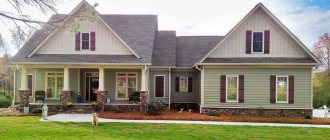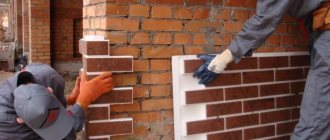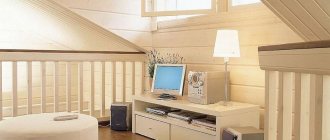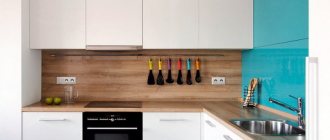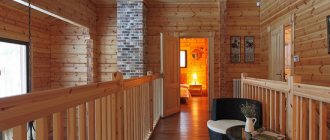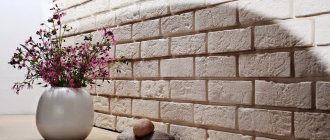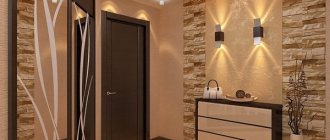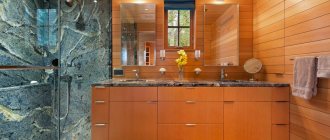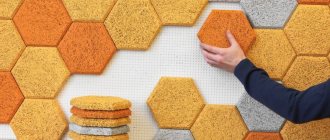Requirements for finishing material
A garage is a specific room. Firstly, in most cases the garage is not heated, so temperature changes will be significant. Secondly, there may be high humidity here. Thirdly, aggressive chemicals and flammable liquids are used in the garage. After all, there are a lot of sources of dirt in this room. The finishing material must withstand all these factors, therefore the following requirements are put forward to it:
- resistance to temperature changes, frost resistance . In an unheated room, a lot of fairly significant temperature jumps can be observed in just one season. Not every finishing material will be able to cope with such an impact while maintaining its integrity and all its performance qualities;
- fire resistance . Gasoline, diesel and many other substances used for car maintenance and care are very flammable. In order for the garage to be a safe place for both the car and its owner, it is necessary to choose materials that are as fire-resistant as possible;
- mechanical strength . Since impacts and collisions in the garage are not excluded, it is better to choose a cladding that can withstand such impacts;
- resistance to aggressive chemicals . Household chemicals that come into contact with some materials can destroy them. If you do not want the cladding to lose its aesthetics and important performance qualities after just a few months of operation, it is better to choose a material that can withstand contact with fuels and lubricants, acids, oils, lubricants and other substances;
- ease of care . A garage is a fairly dirty room, but it is necessary to keep it clean, and it will be easier to do this if you have a lining that is easy and quick to clean;
- price . Everyone’s budget is different, but in each price category there are more or less suitable materials;
- aesthetics. The appearance of the garage wall decoration, of course, matters, but not the key one. Aesthetically, the cladding is required to be neat.
Some car owners would also add ease of updating . Even the strongest and most durable material sooner or later ages, and when this moment comes, it will be better if the cladding is as simple as possible to refresh, or simply replace some of its elements.
Fortunately, there are plenty to choose from, and below we will look at the most suitable materials for interior decoration of garage walls.
Methods for insulating a metal garage
You can insulate a metal garage inside or outside. If the structure is an autonomous building, then the priority option would be to carry out work on the facade side. Often the premises are located inside the complex. In this case, the insulating materials will have to be placed indoors, on the inside.
Insulation of a metal garage from the outside
For external insulation, materials are selected in accordance with the selected finish. If plastering is involved, then it is better to stick to hard slabs. These include expanded polystyrene. Mineral wool and polyurethane foam can also be used under cladding or brickwork made from frost-resistant materials.
As an alternative, manufacturers offer ready-made decorative sheets with insulation. These include rigid slabs to which corrugated sheeting, clinker tiles or plastic panels are glued. They can be installed using a special solution, polyurethane foam or lathing.
Insulation from the outside is completed by painting
Less commonly, brick is used to insulate a metal garage. On its own, this finishing material copes with maintaining heat inside in conditions down to -15 degrees Celsius without wind. In other cases, additional thermal insulation is fixed between the masonry and the metal base and an air gap is created.
Insulation of a metal garage from the inside
The interior space of the garage is often used as a workshop, a place to store tools and things. That is, shelving, a workplace, and tanks can be located around the perimeter. This helps to reduce the area for placing a car.
Insulation of metal walls, protection of thermal insulation sheets, and decorative finishing lead to a reduction in the garage area. Therefore, when choosing materials, their thickness is taken into account. Thin-layer options are polyurethane foam and extruded polystyrene foam.
Polyurethane foam dries relatively quickly, the layer can be 5-6 cm
No. 1. Plaster
This is one of the most budget-friendly, and therefore most popular, ways to decorate a garage space. This cladding method is almost ideal for the requirements described above. The list of advantages is significant:
- relatively low cost, which is what you need for a garage;
- the ability to level and hide minor imperfections in the base, so preparatory work is greatly simplified;
- plaster does not take up useful space, unlike finishing that must be mounted on the frame, for example, drywall;
- wear resistance, strength, relative resistance to mechanical damage;
- fire and mold resistance;
- resistance to temperature changes, moisture resistance;
- durability;
- application speed;
- simple but nice appearance.
No matter how much you would like to, it is still impossible to call plaster an ideal coating for finishing garage walls, and the following disadvantages :
- complexity of application and “dirty” installation process. You should only undertake finishing work yourself if you are 110% confident in your own preparation. Otherwise, it is better to entrust the work to specialists. If mistakes are made during installation of the plaster, then in the first winter, due to temperature changes, cracks will appear on the surface, and some areas will begin to peel off;
- The surface of the plaster gets dirty quickly, and it can be difficult to wash off the dirt. But this drawback can be easily eliminated. After applying a layer of plaster and drying it, the surface is treated with facade paint, which provides additional resistance to moisture, dirt-repellent properties and simplifies maintenance. You can choose any color, thus also solving the issue of the aesthetic side of the cladding.
Plaster can be applied to almost any base, but it will adhere most strongly to walls made of brick, as well as aerated concrete and other concrete blocks. For work, it is better to take a cement-sand based composition.
Video description
About the intricacies of self-leveling flooring in the following video:
Special requirements are imposed on the flooring in the garage; it must withstand significant and regular weight loads from the car. The preferred flooring options are:
- Painted concrete floor . A popular option that can easily support the weight of a car. A concrete floor coated with a primer weakly absorbs spilled auto chemicals, does not collect dust and is resistant to abrasion. Although the process of installing a concrete floor cannot be called quick, many car enthusiasts opt for it due to the low costs and simplicity of the technology.
- Tile . A garage floor made of ceramic tiles (or ceramic tiles) looks neat and often original. The coating is advantageous due to its durability, easy maintenance and resistance to fuels and lubricants. The limiter to the use of tiles is their high cost and the rather labor-intensive process of creating a tile covering (including mandatory waterproofing).
Ceramic tile flooring Source koon.ru
- Poured concrete . Impact-resistant coating with a perfectly flat surface, not inferior in strength to a classic concrete floor. One of the most successful coatings for a garage, as it is frost-resistant and has increased resistance to chemical environments. The disadvantage of this method is the high price of the composition, which is why self-leveling flooring cannot be called an economical option. Another subtlety is that the base for pouring must be perfectly flat, which is not always achievable.
- Wooden floor . The choice in favor of a wooden floor covering (from floorboards) is not often made, although the base for such a floor does not need to be leveled. Many believe that this type of floor has more disadvantages than advantages - flammability, high degree of absorption and low strength. Proponents claim that wood flooring is much more pleasant and healthier to work on; In addition, wood (unlike concrete) does not generate dust.
Self-leveling polymer floor Source ko.decorexpro.com
No. 2. Ceramic tile
Ceramic tiles are another material that almost completely meets all the requirements put forward, which is why this type of cladding is often found in garages. Its main advantages include:
- resistance to moisture and frost resistance, so harsh garage operating conditions will not particularly damage the coating;
- fire resistance;
- hygiene. Dirt does not stick to the surface, and if something happens, almost any dirt can be washed off the wall with minimal effort;
- sufficient strength;
- durability;
- wide choice and aesthetics. Ceramic tiles are produced in almost all colors, shapes and sizes, and manufacturers’ collections are replenished every season, so it will not be difficult to find a suitable material in this variety. Even the simplest plain tile will look great. From an operational point of view, it is best to go with clinker - it is stronger than ordinary tiles, although it does not have such a wide variety of colors.
There were some downsides :
- the cost of the material, as well as the need to pay for its proper installation if you can’t do it yourself;
- weight. Tile is a heavy material, so the optimal base for it would be brick walls;
- relatively long installation.
Since the main deterrent to the widespread use of tiles in garages is their price, you can use a trick by combining materials . The lower part of the walls is the most vulnerable, so clinker can be used here, and the rest can be made from cheaper tiles. You can make the bottom of tiles and finish the top with plaster. In this case, we get all the benefits inherent in tiled flooring, but we can save a lot.
No. 3. Drywall
Drywall has conquered not only residential premises, but also technical ones. So sheets of plasterboard are now often used to decorate garage walls. Naturally, only those that have additional protection from moisture and fire . You can recognize this material by its gray-green color, red markings and the name GKLVO.
Advantages:
- low cost;
- light weight of the material, relatively simple and quick installation, absence of dirt, dust and debris during the installation process (unlike plaster);
- thorough preparation of the base is not required - all holes, cracks and other defects will be hidden behind even and smooth sheets of drywall;
- when installing drywall on a frame, free space is created between the base and the sheets themselves, which can be used to place insulation;
- resistance to fire and moisture.
Flaws:
- when installing sheets on a frame, the area of the room will be reduced, so if the garage is small, carefully carry out the calculations and try to assess how the room will change after finishing. There is also an adhesive installation method, then the area of the room is not reduced, but the possibility of insulation disappears;
- the need for additional cladding, since the surface of the plasterboard is not very attractive, given the presence of seams. In addition, finishing will improve some of the performance qualities of the material;
- low impact resistance, but this disadvantage can be negated by using ceramic tiles as finishing - drywall will withstand such a load;
- It is difficult to wash the surface of plasterboard from contaminants, so it is better to paint it with moisture-resistant washable paints - this is the simplest and most cost-effective option for finishing plasterboard walls.
Drywall in a garage can be used not only for finishing walls, but also for constructing partitions, as in apartments. If you need to allocate, for example, an area for a storage room or workshop, then you will only need to build a frame and cover it with sheets.
Garage finishing materials
Based on the characteristics mentioned above, you can analyze various cladding options and take into account their advantages and disadvantages.
Concrete finishing
Plastering the walls and pouring a concrete floor screed are traditional finishes for a garage space. This approach fully complies with most of the criteria discussed above, and the material itself holds up well on walls made of brick, concrete or aerated concrete blocks.
One of the simplest and most affordable options is plastered walls and a smooth concrete screed on the floor.
The positive qualities of such a simple finish include fire resistance, strength, durability, resistance to mechanical stress, ease of repair if the need arises, and the ability to achieve the intended look using painting.
Of course, this method also has its disadvantages:
- These include, first of all, the labor intensity of mixing the solution and leveling it on the surfaces of the walls.
- To finish walls and floors with cement-sand plaster, you need to have some finishing skills, since minor shortcomings in such work can appear after a few months, at the first temperature changes - this is usually manifested by the appearance of cracks, swelling, peeling or crumbling of the material.
- In addition to the laboriousness of applying and leveling the mortar and arranging the screed, it is also necessary to take into account the fact that this is a rather “dirty” process that requires large-scale cleaning upon completion.
- Having decided to choose this type of cladding, you should immediately take into account the fact that decorative finishing of plastered surfaces will also require expenses, which will extend their service life and give them an aesthetic appearance.
Plastering walls yourself is not an easy task.
Plastering walls requires good work skills and a certain dexterity. Therefore, if you decide to try your hand at finishing garage walls like this, it is recommended that you first familiarize yourself with the “basics” of the technology by following the link to the article on plastering walls with your own hands .
The recommended publication will introduce you not only to the work process itself, but also to the materials that it is advisable to use for this.
Concrete garage floor - a reliable foundation
A concrete screed on the garage floor can act as a final covering, or act as a reliable basis for laying other material. How best to arrange the floor in the garage , including with a high-quality ventilated inspection pit - read in a separate publication on our portal.
It will be necessary to level the floor with a screed even if ceramic or modular tiles are chosen as the floor covering, the installation of which requires a flat, durable surface. However, for a wooden garage floor, a concrete base will also not be superfluous.
Prices for plaster mixtures
plaster mixtures
Using drywall
Instead of the “wet” plastering method, to level the walls you can use the so-called “dry plaster”, better known to everyone as plasterboard. GVL sheets can be attached directly to the wall with special glue or to a metal frame. The latter option is used in cases where the surface has large distortions or if it is planned to be insulated. True, this will be to the detriment of free space in the garage.
To decorate a garage, it is better to use sheets with increased moisture and fire resistance characteristics (GKLVO), which are distinguished by a gray-green color with red markings.
To decorate garage walls, moisture-resistant and fire-resistant plasterboard, designated GKLVO, is usually used - it is classified in the lowest flammability group G1. Sheets of this material are painted gray-green and have red markings on them.
Drywall, like all materials, has its pros and cons.
The first include:
- relatively low weight of sheets;
— ease of installation;
— in comparison with the “wet” method of applying plaster, the process of fixing sheets to the wall and ceiling takes place without unnecessary construction waste;
— affordable price for the material itself and for installation work;
- with certain preparation, plasterboard can become flexible, and it can be used to cover not only flat surfaces, but also arched structures, as well as two-tier ceilings of complex configurations;
— the gypsum contained in the sheet structure tends to absorb excess moisture at high air humidity, and when it is dry, release it into the environment;
- you can create partitions from sheets of plasterboard by attaching it to a frame - this is important when you plan to separate a small room in the garage for changing clothes or for a mini-warehouse or workshop;
— on walls lined with this material, you can attach any decorative finish, from relief plaster to ceramic tiles.
The only disadvantage of finishing walls with plasterboard installed on a frame is the low impact resistance of the sheets. If the sheets are lined with durable material, such as ceramic tiles, this drawback will be insignificant.
In the case where the garage is not planned to be insulated, or thermal insulation will be mounted on the outer surface of the walls, and the interior will be finished with plasterboard, then it is better to use frameless installation technology.
Is it difficult to attach drywall to walls without a frame?
In some ways, this is even easier than installing frame sheathing. How to attach drywall to walls without profiles - read in a special publication on the portal, which describes both the technology itself and the necessary materials.
In addition to leveling and finishing walls, plasterboard is perfect for covering the ceiling. Using it, it’s quite easy to make the ceiling plane perfectly flat and smooth. To create a suspended structure on which the cladding will be attached, a special metal profile is used.
Drywall prices
drywall
Smooth ceiling in the shortest possible time!
The technology for installing a frame under plasterboard ceiling sheathing is similar to creating the sheathing used for installing plywood, OSB, and fiberboard. Therefore, if you plan to use any of these materials, you should carefully study the article “Do-it-yourself suspended ceiling made of plasterboard .
This article contains not only instructions for installing frame elements to the main surface of the ceiling, but also for conducting electrical wiring, as well as installing lighting fixtures built into a plasterboard structure.
Garage finishing with ceramic tiles
Ceramic tiles almost perfectly meet the requirements that must be met when choosing a finish for a garage space.
An ideal monitor for a garage - the floor and walls are finished with high-quality clinker tiles
The tile gives neatness to surfaces, it is waterproof and fireproof, and can also be easily cleaned both with dry cleaning and with detergents, and it will not be damaged by small abrasive particles included in cleaning compositions. Properly laid tiles will become a reliable surface covering that will withstand high loads.
For cladding a room such as a garage, it is recommended to use clinker or porcelain stoneware finishing materials, which have high strength and a matte, non-slip surface. Of course, if you want to save money, you can also use ordinary ceramic tiles for the walls, matching them in color to the clinker floor covering. In addition, you can decorate with high-quality tiles only the lower part of the walls, which is more susceptible to dirt and damage, and leave the top plastered and painted, choosing paint to match the tiles.
The floor is covered with porcelain tiles, and the walls are painted to match it
The disadvantage of ceramic wall finishing is its rather heavy weight and the relatively high price of both the material itself and its installation. Therefore, before planning a purchase, it is worth obtaining information about the cost of tiles in the region where the garage is located and calculating the required quantity.
The finishing material is mounted on well-plastered surfaces and an ideally equipped screed, so in general, such cladding and preparatory measures for it will not be cheap.
Want to take on the challenge of laying ceramic tiles yourself?
We will try to help our reader in choosing the optimal tile and calculating its required quantity, with the selection of glue and with a detailed description of installation work. All these questions are in the publication of the portal “Laying ceramic tiles with your own hands .
Decorating garage walls with clapboard
Another fairly popular group of materials for finishing the walls and ceiling of a garage is lining - made of natural wood or plastic (PVC).
Garage, the walls and ceiling of which are lined with plastic lining
This finishing material (according to its design data) has a number of positive qualities, which include:
— ease of installation on a wall or on a sheathing fixed to a permanent surface;
— the ability to install panels both vertically and horizontally, at the request of the owner;
— the design of the sheathing under the lining allows you to create a gap into which, if desired, insulation can be installed - polystyrene foam or mineral wool.
Garage completely lined with natural wood
The physical and technical characteristics of linings made from different materials vary significantly. Therefore, before choosing one of them, you need to decide which one is more suitable for finishing the garage.
Wooden lining
Panels made from natural wood, when used as cladding for a garage, have their advantages and disadvantages.
If you decide to use natural lining for cladding the walls and ceiling in the garage, then the wood must be subjected to certain preparation
The advantages of wooden panels include their following characteristics (provided that the wood has undergone high-quality treatment with protective compounds - antiseptic and fire retardants):
— frost resistance;
— flame retardants significantly reduce flammability to category G2;
— resistance to mechanical stress;
— durability;
— environmental cleanliness;
- a wide selection of natural, calm color shades and textured patterns.
The obvious disadvantages of untreated wooden lining include:
- high hygroscopicity, and as a result - the likelihood of mold colonies and further destruction of wood fibers;
— susceptibility to damage by insect pests;
— difficulty in cleaning the surface from oil and gasoline stains;
— high flammability of the material, determined by group G4;
- not too long service life.
Since wood is a natural material, it has a higher cost than PVC panels, regardless of whether it has undergone protective treatment or not.
It should be noted that if you have the opportunity to purchase high-quality untreated wooden lining, you can save a lot of money by “bringing it to mind” yourself. For this purpose, a special impregnating composition is purchased, which includes fire retardants and antiseptic components. This product will significantly reduce the flammability of the material, protect it from pests, and also give it a pleasant warm shade. If the protective agent is applied in two or three layers, then it can even replace a varnish coating. Although, for the conditions of using wooden cladding in a garage, a layer of varnish will also never be superfluous, since it will protect the cladding from absorbing oil stains and will allow wet cleaning of the walls.
How is wooden lining installed?
Even a novice master who has not previously performed such operations should be able to cope with such a task. The technology for finishing lining with your own hands with all the details in a special publication on our portal.
You can immediately note that PVC lining, also used for cladding walls or ceilings, is mounted according to the same principle.
The garage floor can also be covered with planks. Tongue-and-groove boards are also connected to each other using the tongue-and-groove principle, but, naturally, they have a greater thickness, which can vary from 35 to 50 mm, since the maximum pressure falls on the floors, taking into account the weight of the car and dynamic loads. Boards, just like wooden panels for walls, must go through a cycle of preliminary preparation. However, it should be rightly noted that a wooden floor for a garage cannot be considered the best covering option.
Plastic panels
PVC panels, like any building material, have their disadvantages and advantages, which you also need to know when choosing cladding for garage walls.
First of all, it should be noted that for the conditions under consideration, it is recommended to purchase material intended for cladding facades or specifically for the garage, since it has more suitable characteristics, especially considering the fact that most often this room is unheated.
Walls and ceilings lined with plastic lining panels look very neat
So, the advantages of PVC cladding can be called its following qualities:
— plastic lining is easy to clean from various contaminants;
— the light weight of the panels simplifies their installation, which can be done on a frame sheathing or directly on the wall;
— low hygroscopicity, that is, the finish practically does not absorb water;
— facade panels tolerate temperature changes well, except extremely low ones;
— a variety of colors and patterns, including imitation of wooden texture;
- aesthetics of the material;
— does not require additional processing and painting;
— fairly high strength;
— it’s easy to replace single, accidentally damaged lamellas without dismantling the entire casing;
— low cost of finishing;
- Possibility to carry out installation yourself.
The disadvantages of plastic lining are:
- flammability category G2, that is, they are not able to ensure fire safety;
— at very low temperatures the material becomes brittle and can break under mechanical stress.
If you plan to install the lining on the sheathing, you need to take into account that the area of the garage will decrease by approximately 60÷70 mm on each side.
Installation of plastic lining is accessible to everyone
The most important operation is to correctly install the frame sheathing, and further actions already resemble playing with a children's construction set. How installation work on covering the ceiling with plastic panels - read in a separate publication on our portal.
Sheathing walls and ceilings with OSB sheets
Garage walls that are insulated from the inside can also be covered with plywood, or even better, with OSB sheets (oriented strand board), consisting of several layers of thin wood shavings that are relatively large in size.
OSB sheets can be an excellent material for wall cladding in a garage.
Manufacturers use different materials as binders for crushed wood - these can be coniferous tree resins and paraffins or formaldehyde resins. In any case, the polymerization of these substances is completed 2–3 months after the sheets are manufactured, therefore the evaporation of harmful substances stops after approximately the same time, and they will no longer pose a significant danger in terms of formaldehyde emissions.
Table of permissible characteristics of OSB panels (sheets):
| Indicators | Unit | Sheet thickness in mm. | |||
| 6÷10 | 10÷18 | 18÷25 | 25÷30 | ||
| Tolerances of nominal dimensions in length and width. | mm | ±3 | ±3 | ±3 | ±3 |
| Thickness tolerances. | mm | ±0,8 | ±0,8 | ±0,8 | ±0,8 |
| Squareness, maximum deviations | Mmm | 2 | 2 | 2 | 2 |
| Humidity | % | 2÷12 | 2÷12 | 2÷12 | 2÷12 |
| Density variation within one sheet | % | ±15 | ±15 | ±15 | ±15 |
| Formaldehyde content according to EN-13986 | Class E1 maximum 8 mg/100 g; Class E2 maximum 8÷30 mg/100 g. | ||||
| Density | kg/m³ | 620÷635 | 595÷615 | 570÷590 | 550±10% |
OSB (in the foreign abbreviation OSB) is divided into several types and have a numerical designation from 1 to 4. For cladding the walls and ceiling of a garage, you should choose OSB-3 or OSB-4 sheets, since their characteristics correspond to the maximum extent to the conditions of this room.
OSB-3 is the most used type of material. It has fairly high strength and average moisture resistance, but if the sheets are used in unheated rooms, they must be pre-treated with moisture-repellent compounds.
OSB-4 is the most durable type, which can be used for both interior and exterior decoration. The material perfectly resists external influences and tolerates temperature changes well. True, the price for this type of OSB is significantly higher than the cost of all other varieties.
The positive qualities of OSB-4 also include the following:
— Low level of moisture absorption, so the sheets do not deform, swell or become moldy under the influence of high air humidity.
— Long service life.
- Light weight and... in this regard - ease of installation.
— Good thermal and sound insulation performance.
— Antiseptic additives included in OSB prevent biological decomposition, the appearance and development of microflora and insect nests.
— Affordability, compared to many other types of cladding.
The disadvantages of OSB include the maximum flammability category of the panels - G4, as well as the above-mentioned emission of formaldehyde included in the binders. However, for garage conditions even class E2 will be quite acceptable.
Tile adhesive fits perfectly onto primed OSB sheathing, and the walls can be additionally lined with ceramic tiles or “flexible stone”
OSB lends itself well to painting, but the panels must be primed first. In addition, walls covered with such material can be lined with ceramic tiles or “flexible stone” mounted with tile adhesive. This finishing will provide additional protection for the walls from contamination and increase overall fire safety.
Video: Another option for cladding garage walls - corrugated sheeting
Modular floor covering
Modular garage floor coverings are one of the relatively new types of finishing materials that are produced on various bases - these can be polyvinyl chloride (PVC) and rubber slabs.
New modular garage floor coverings are very easy to use
PVC floor modules
The practicality of such a coating is undeniable, and this is especially true for PVC panels, since they are designed to withstand heavy loads and any mechanical stress. Moreover, the modules can be laid not only in the garage itself, but also on the site in front of it, of course, if the building is located in a closed area, or the coating will have to be fixed to the surface using special glue.
Modular PVC boards are characterized by the following positive qualities:
- The material is resistant to high and low temperatures from -30 to +50 degrees.
- A great advantage is its complete inertness to petroleum products and technical fluids traditionally used in garages.
- Easy to install and dismantle the slabs - the installation technology does not require special skills.
- The garage can be used immediately after laying the covering, since it does not require any period of drying and strength gain (except in the case of installing the slabs with an adhesive solution).
- High strength of the coating – both to static and dynamic and impact loads.
- Such a coating does not require special preparation of the base, the main thing is that it is smooth, stable and durable.
Laying PVC modules on a concrete screed using special glue
- The slabs are installed on a concrete or wooden base, and the modules can be glued with special glue or even laid without rigid fixation.
- Modular PVC covering is an environmentally friendly material, so it is often used even in children's institutions to decorate the floors of halls or cover outdoor playgrounds.
PVC modules can have a pronounced relief or simply a rough surface. In any case, it does not slip, which is very important for the floor of unheated rooms at subzero temperatures. Although many slabs have a textured surface, they are easy to maintain using dry or wet cleaning methods.
This coating will prevent you from slipping even on a wet floor.
The variety of colors of modular slabs allows you to create a multi-colored coating, which makes it possible to create an exclusive garage design. Bright colors, well matched to each other, will to a certain extent lift and maintain the working mood. In addition, a floor covering made in this way will add neatness and decorativeness to the garage space.
Rubber modules
Rubber modules have characteristics no worse than PVC plates. They are also used for garage floors, sports fields and even garden paths. The modules can have different connections or be laid like puzzles, like some models of paving slabs. The material is produced in different thicknesses, but any of them fits well even on a not entirely flat surface, taking the form of small smooth depressions.
Prices for OSB sheets
OSB sheets
A rubber modular floor covering would also be an excellent solution for a garage.
Rubber tiles, depending on their configuration, can be glued to the surface or simply laid by interlocking the modules with special locking connections.
Rubber flooring has positive qualities that also meet the previously discussed requirements for garage finishing:
- Resistant to high loads and mechanical stress.
- High wear resistance.
- Environmental Safety.
- Inert to various chemical compounds.
- Easy to maintain and repair.
- The safety of the coating, as it does not slip at any temperature.
No. 4. PVC panels
Relatively cheap PVC panels are used to finish both walls and ceilings in the garage. They are mounted, like drywall, on a frame, or directly on the wall. Among the main advantages of the material :
- low price;
- high resistance to moisture;
- ease of care. Almost any contamination can be washed off the surface of the panel without much effort;
- light weight: the material will not load the walls and foundation, so the panels can be mounted in garages built from any materials;
- simple installation, and if the frame method is used, then insulation can be used;
- maintainability. If any part of the finishing has become unusable, then it is enough to simply replace it with a new one;
- high temperature resistance
- there is no need for additional finishing, since the panels themselves have a good appearance and are already well protected from moisture.
Minuses:
- The panel is easily damaged even with a slight impact. The appearance of cracks affects not only the appearance, but also the performance. However, the problem can be solved by easily replacing the damaged panel;
- sensitivity to temperature changes, so it’s better not to save money and buy panels designed for facade work. You can also find on sale a special finish designed for cladding a garage - such panels cope better with constant temperature changes and are designed for use in an unheated room;
- During the first time after installation, an unpleasant odor may appear, but it quickly dissipates.
Floor and ceiling finishing
The roof for garages is usually made flat. This saves money and effort, but at the same time increases the likelihood of leakage when water after rain lingers on a horizontal surface. Therefore, the decorative covering of the ceiling in the garage begins after waterproofing it. One of the most common methods is plastering the ceiling and then painting it. Since the ceiling is not damaged, the choice is often made in favor of MDF or PVC panels. This is a popular and practical option that allows (when using a frame) insulation and hiding communication systems.
No. 5. Wooden lining
If the garage serves not only as a place to park your car and repair it, but also as a place for privacy and meeting with friends, you can choose an aesthetically pleasing finish made of wooden lining.
Advantages:
- excellent appearance, environmental friendliness;
- high heat and sound insulation qualities;
- relatively low cost, especially when it comes to softwood lining, which is what is used in garages;
- high strength, resistance to mechanical damage;
- easy installation on wooden sheathing. The panels themselves are tightly connected thanks to the tongue-and-groove system;
- the lining has a small coefficient of thermal expansion, so the coating does not deform when temperature changes occur.
Disadvantages expected for wood flooring:
- fear of high humidity;
- fear of fire;
- high possibility of damage by pests and mold;
- Difficult to maintain, since stains from household chemicals are difficult to clean.
If you use a number of protective agents, then some qualities of wood can be significantly improved. Fire retardants will increase fire resistance, antiseptics will protect against mold, and varnishing will simplify routine cleaning procedures, since oil and other liquids will not be absorbed into the porous, hygroscopic surface of the wood.
How to properly insulate a metal garage
Thermal insulation in a metal garage is installed using an adhesive solution, special fasteners, sheathing, sprayed or applied with a brush. Options with foam, liquids and solutions require additional priming of the prepared surface. When choosing, the operating conditions are taken into account: temperature changes with humidity, the nature of the base and finishing. In other cases, you need to assemble the sheathing or frame. Drilling of technological holes may be necessary.
This is what a wooden sheathing under tile or roll insulation looks like
Insulation of an iron garage with foam plastic
Expanded polystyrene is relevant for processing smooth and even metal walls and ceilings to prevent the formation of voids. They can cause peeling of the insulation and cause condensation to accumulate.
Comment! Depending on the density in central Russia, the thickness of the slabs should be 70-100 mm.
In order to save money, it is better to fix heat-insulating sheets with special glue, foam or liquid nails. If the sheathing is laid in the grooves, then a gap of about 10-15 mm must be maintained between the profile or beam and the foam plastic. All joints are filled with low expansion foam to prevent sheet deformation.
Insulation of a metal garage with polyurethane foam
Thermal insulating foam in a metal garage is sprayed after the sheathing is installed. It is needed so that further finishing can be done with cladding materials. According to the installation technology, the base with the frame must be dry, and the ambient temperature must be more than +10 degrees Celsius. After the working mass has dried, the excess is removed using a construction knife.
Insulation of a metal garage with mineral wool
The sheathing for fiber webs is attached to a frame made of wooden beams or metal profiles. As a base for them, frame racks with guides and a metal profile of the building are used. Self-tapping screws are screwed in at intervals of 20-30 cm. Grooves for insulation for a metal garage are formed in accordance with the parameters of thermal insulation sheets and slabs, only you need to reduce the width and height by 2 cm around the perimeter. This will ensure a tight fit of the mineral wool to the elements of the supporting structure.
Moisture-absorbing material must be protected from exposure to vapors. To do this, waterproofing is installed on the side of the metal base. Before decorative finishing, a vapor-proof fabric is laid. It is better to use membrane material for these purposes. The edges are overlapped by 10-15 cm and sealed with double-sided tape. For fixation, use adhesive tape or construction staples with intermediate slats.
If decorative finishing is not followed, then the vapor barrier fabric must be resistant to chemicals
No. 6. Corrugated sheet
If there is a workshop or even a miniature service station in the garage, then the best option to cover the walls is to use corrugated sheeting. It's inexpensive and very practical. The steel sheet is protected with a polymer or paint coating, so the material withstands various types of influences well. The relief that is given to the steel sheet gives it additional strength.
pros:
- strength, the material can withstand mechanical damage;
- resistance to high humidity and temperature fluctuations;
- resistance to aggressive chemicals;
- quick and easy installation;
- durability;
- wide selection of colors.
Corrugated sheeting can be used as a material for covering already constructed garage walls, but more often it performs two functions at once: material for constructing garage walls and finishing, i.e. The walls are built from corrugated sheets and do not undergo additional cladding.
The disadvantage is often called low resistance to corrosion, but if the corrugated sheet is covered with a polymer coating that was not damaged during installation, then the material is not afraid of corrosion. It is more difficult to deform a steel sheet than a plastic lining, but replacing the damaged area will be more troublesome.
No. 7. Plywood and OSB
Plywood and oriented strand boards are not used very often for garage finishing, but this option still exists. Plywood will have to be additionally coated with a means to increase moisture resistance, but OSB comes with moisture protection (OSP-4).
pros:
- relatively low price;
- resistance to moisture, if the material of the appropriate class is selected;
- high level of strength;
- resistance to temperature changes;
- durability;
- resistance to mold if treated with antiseptics.
Minuses:
- flammability. Despite manufacturers' attempts to somehow solve this problem, sheets of plywood and OSB literally burst into flames when exposed to fire;
- OSB sheets contain formaldehyde resins, so when purchasing, you should pay attention to the level of their emission, and also ensure good ventilation in the garage.
No. 8. Concrete
The most affordable option for finishing garage walls is to use concrete. True, provided that concrete was also chosen for the floor covering, you will end up with a not very attractive gray box, but the arrangement will not cost a pretty penny, everything will be reliable and durable.
Advantages:
- high strength;
- resistance to fire;
- high level of maintainability, so the occurrence of cracks and other defects should not upset you;
- low cost;
- acceptable frost resistance;
- normal moisture resistance, which can be increased by covering the walls with varnish or paint;
- resistance to oil, fuel and other liquids;
- high adhesion to brick and concrete blocks.
Minuses:
- complexity of work, labor intensity. In addition, the lack of necessary skills in finishing work can result in the appearance of cracks in concrete;
- installation of concrete pavement is a “dirty” process;
- dubious aesthetics, but in the garage you can put up with this drawback.
